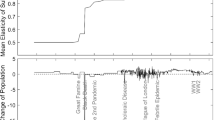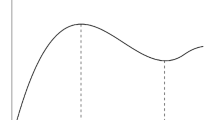Abstract
Fertility has been declining on all continents for the last couple of decades and this development is expected to continue in the future. Prevailing innovation-based growth theories imply, as a consequence of scale effects from the size of population, that such demographic changes will lead to a major slowdown in productivity growth. In this paper we challenge this pessimistic view of the future. By allowing for endogenous human capital in a basic R&D driven growth model we develop a theory of scale-invariant endogenous growth according to which population growth is neither necessary nor conductive for economic growth.
Similar content being viewed by others
References
Aghion, P., and P. Howitt. (1992). “A Model of Growth Through Creative Destruction,” Econometrica 60, 323-351.
Aghion, P., and P. Howitt. (1998). Endogenous Growth Theory. MIT Press.
Barro, R. (1991). “Economic Growth in a Cross Section of Countries,” Quarterly Journal of Economics 106, 407-443.
Dinopoulos, E., and P. Thompson. (1998). “Schumpeterian Growth without Scale Effects,” Journal of Economic Growth 3, 313-335.
Dinopoulos, E., and P. Thompson. (1999). “Scale Effects in Schumpeterian Models of Economic Growth,” Journal of Evolutionary Economics 2, 157-185.
Grossman, G. M., and E. Helpman. (1991). Innovation and Growth in the Global Economy. MIT Press.
Groth, C. (1997). “R&D, Human Capital, and Economic Growth,” Working Paper, University of Copenhagen.
Hall, R. E., and C. I. Jones. (1999). “Why Do Some Countries Produce So Much More Output Per Worker Than Others?” Quarterly Journal of Economics 114, 83-116.
Howitt, P. (1999). “Steady Endogenous Growth with Population and R&D Inputs Growing,” Journal of Political Economy 107(4), 715-730.
Jones, C. I. (1995). “R&D-based Models of Economic Growth,” Journal of Political Economy 103, 759-783.
Jones, C. I., and J. C. Williams. (1998). “Measuring the Social Return to R&D,” Quarterly Journal of Economics 113, 1119-1135.
Kortum, S. (1997). “Research, Patenting and Technological Change,” Econometrica 65, 1389-1419.
Kremer, M. (1993). “Population Growth and Technological Change: One Million B.C. to 1990,” Quarterly Journal of Economics 108, 681-716.
Mankiw, G., D. Romer, and D. Weil. (1992). “A Contribution to the Empirics of Economic Growth,” Quarterly Journal of Economics 107, 407-435.
Peretto, P. F. (1998). “Technological Change and Population Growth,” Journal of Economic Growth 3, 283-311.
Psacharopoulos, G. (1994). “Returns to Investment in Education: A Global Update,” World Development 22, 1325-1343
Rivera-Batiz, L., and P. Romer. (1991). “Economic Integration and Endogenous Growth,” Quarterly Journal of Economics 106, 531-555.
Romer, P. (1986). “Increasing Returns and Long-run Growth,” Journal of Political Economy 94(5), 1002-1037.
Romer, P. (1990). “Endogenous Technical Change,” Journal of Political Economy 98, 71-102.
Segerström, P. S. (1999). “Endogenous Growth Without Scale Effects,” American Economic Review 88, 1290-1310.
Sørensen, A. (1999). “R&D, Learning, and Phases of Economic Growth,” Journal of Economic Growth 4, 429-445.
United Nations. (1998). World Population Projections to 2150. Department of Economic and Social Affairs, Population Division, New York.
Young, A. (1998). “Growth without Scale Effects,” Journal of Political Economy 106, 41-63.
Author information
Authors and Affiliations
Rights and permissions
About this article
Cite this article
Dalgaard, CJ., Kreiner, C.T. Is Declining Productivity Inevitable?. Journal of Economic Growth 6, 187–203 (2001). https://doi.org/10.1023/A:1011343715594
Issue Date:
DOI: https://doi.org/10.1023/A:1011343715594




